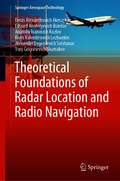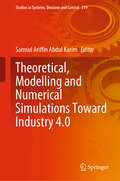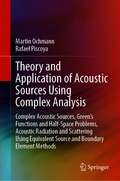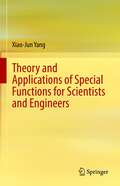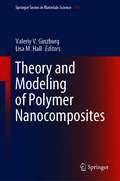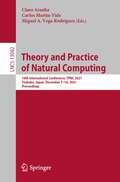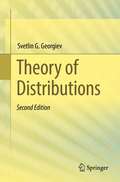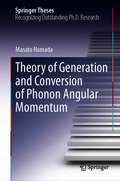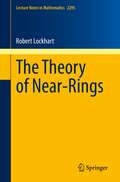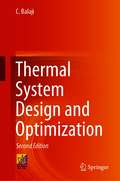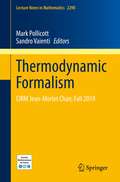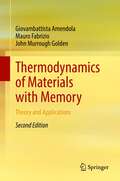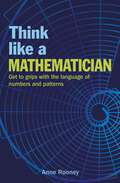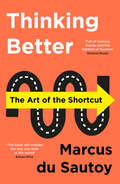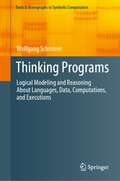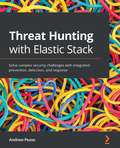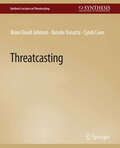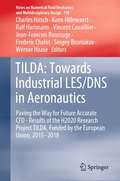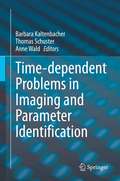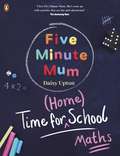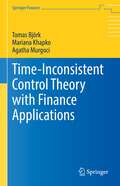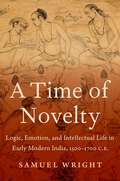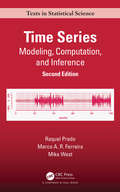- Table View
- List View
Theoretical Foundations of Radar Location and Radio Navigation (Springer Aerospace Technology)
by Denis Alexandrovich Akmaykin Eduard Anatolyevich Bolelov Anatoliy Ivanovich Kozlov Boris Valentinovich Lezhankin Alexander Evgenievich Svistunov Yury Grigorievich ShatrakovThe book represents a study guide reciting theoretical basics of radar location and radio navigation systems of air and sea transport. This is the distinctive feature of this study guide.The study guide states the principal physics of radar location and radio navigation, main measuring methods of proper and relative movement parameters of an object, tactical and technical characteristics of radar location and radio navigation systems, including examining issues on radiofrequency signals detection and its parameters estimation against background and interference of different type, filtering, combined detection and rating of signals, signals resolution and classification. The structural and functioning principles of the current and advanced radar location and radio navigation systems of air and sea transport are represented in the study guide with an adequate completeness. The study guide features the result of years long lecturing on radar location and radio navigation theoretical courses at the Moscow State Technical University of Civil Aviation and G.I.Nevelskiy Maritime State Technical Academy. The study guide is designated for students of radio-engineering specialties in area of air and sea transport. The study guide can be useful for radio engineers working in the field of air and maritime transport, and for graduate students and academic researchers as well.
Theoretical, Modelling and Numerical Simulations Toward Industry 4.0 (Studies in Systems, Decision and Control #319)
by Samsul Ariffin Abdul KarimThis book presents theoretical modeling and numerical simulations applied to drive several applications towards Industrial Revolution 4.0 (IR 4.0). The topics discussed range from theoretical parts to extensive simulations involving many efficient algorithms as well as various statistical techniques. This book is suitable for postgraduate students, researchers as well as other scientists who are working in mathematics, statistics and numerical modeling and simulation.
Theory and Application of Acoustic Sources Using Complex Analysis: Complex Acoustic Sources, Green’s Functions and Half-Space Problems, Acoustic Radiation and Scattering Using Equivalent Source and Boundary Element Methods
by Martin Ochmann Rafael PiscoyaThis book highlights the mathematical and physical properties of acoustical sources with singularities located in the complex plane and presents the application of such special elements to solve acoustical radiation and scattering problems. Sources whose origin lies in the complex plane are also solutions of the wave equation but possess different radiating properties as their counterparts with real positions. Such mathematical constructions are known in the fields of optics and electrodynamics, but they are not common in acoustical research. The objective of the book is to introduce this concept to acousticians and motivate them to engage themselves in further research and application of complex sources. Such sources are particularly useful to formulate Green’s functions and related equivalent source and boundary element methods in half-spaces.
Theory and Applications of Special Functions for Scientists and Engineers
by Xiao-Jun YangThis book provides the knowledge of the newly-established supertrigonometric and superhyperbolic functions with the special functions such as Mittag-Leffler, Wiman, Prabhakar, Miller-Ross, Rabotnov, Lorenzo-Hartley, Sonine, Wright and Kohlrausch-Williams-Watts functions, Gauss hypergeometric series and Clausen hypergeometric series. The special functions can be considered to represent a great many of the real-world phenomena in mathematical physics, engineering and other applied sciences. The audience benefits of new and original information and references in the areas of the special functions applied to model the complex problems with the power-law behaviors.The results are important and interesting for scientists and engineers to represent the complex phenomena arising in applied sciences therefore graduate students and researchers in mathematics, physics and engineering might find this book appealing.
Theory and Modeling of Polymer Nanocomposites (Springer Series in Materials Science #310)
by Valeriy V. Ginzburg Lisa M. HallThis edited volume brings together the state of the art in polymer nanocomposite theory and modeling, creating a roadmap for scientists and engineers seeking to design new advanced materials. The book opens with a review of molecular and mesoscale models predicting equilibrium and non-equilibrium nanoscale structure of hybrid materials as a function of composition and, especially, filler types. Subsequent chapters cover the methods and analyses used for describing the dynamics of nanocomposites and their mechanical and physical properties. Dedicated chapters present best practices for predicting materials properties of practical interest, including thermal and electrical conductivity, optical properties, barrier properties, and flammability. Each chapter is written by leading academic and industrial scientists working in each respective sub-field. The overview of modeling methodology combined with detailed examples of property predictions for specific systems will make this book useful for academic and industrial practitioners alike.
Theory and Practice of Natural Computing: 10th International Conference, TPNC 2021, Virtual Event, December 7–10, 2021, Proceedings (Lecture Notes in Computer Science #13082)
by Claus Aranha Carlos Martín-Vide Miguel A. Vega-RodríguezThis book constitutes the refereed proceedings of the 10th International Conference on Theory and Practice of Natural Computing, TPNC 2021, held virtually, in December 2021. The 9 full papers presented together with 3 invited talks, in this book were carefully reviewed and selected from 14 submissions. The papers are organized in topical sections named Applications of Natural Computing, Deep Learning and Transfer Learning, Evolutionary and Swarm Algorithms.
Theory of Distributions
by Svetlin G. GeorgievThis book explains many fundamental ideas on the theory of distributions. The theory of partial differential equations is one of the synthetic branches of analysis that combines ideas and methods from different fields of mathematics, ranging from functional analysis and harmonic analysis to differential geometry and topology. This presents specific difficulties to those studying this field. This second edition, which consists of 10 chapters, is suitable for upper undergraduate/graduate students and mathematicians seeking an accessible introduction to some aspects of the theory of distributions. It can also be used for one-semester course.
Theory of Fermi-liquids in Metals: A Compact Overview as an Introduction to Theoretical Solid-State Physics (essentials)
by Michael KinzaThis essential offers a compact introduction to the theory of Fermi liquid for physics students in their main studies. It forms the basis for an understanding of theoretical solid state physics and is part of every introductory lecture on this topic. After a brief overview of the Sommerfeld model of metals, the concept of the quasiparticle is introduced. Important calculations characterizing a Fermi liquid are derived in detailed calculations. The essential concludes with an overview of the microscopic theory of Fermi liquids.This Springer essential is a translation of the original German 1st edition essentials, Theorie der Fermiflüssigkeit in Metallen by Michael Kinza, published by Springer Fachmedien Wiesbaden GmbH, part of Springer Nature in 2018. The translation was done with the help of artificial intelligence (machine translation by the service DeepL.com). A subsequent human revision was done primarily in terms of content, so that the book will read stylistically differently from a conventional translation. Springer Nature works continuously to further the development of tools for the production of books and on the related technologies to support the authors.
Theory of Generation and Conversion of Phonon Angular Momentum (Springer Theses)
by Masato HamadaThis book presents a theoretical study of the generation and conversion of phonon angular momentum in crystals.Recently, rotational motions of lattice vibrations, i.e., phonons, in crystals attract considerable attentions. As such, the book theoretically demonstrate generations of phonons with rotational motions, based on model calculations and first-principle calculations. In systems without inversion symmetry, the phonon angular momentum is shown to be caused by the temperature gradient, which is demonstrated in crystals such as wurtzite gallium nitride, tellurium, and selenium using the first-principle calculations. In systems with neither time-reversal nor inversion symmetries, the phonon angular momentum is shown to be generated by an electric field. Secondly, the book presents the microscopic mechanisms developed by the author and his collaborator on how these microscopic rotations of nuclei are coupled with electron spins. These predictions serve as building blocks for spintronics with phonons or mechanical motions.
The Theory of Near-Rings (Lecture Notes in Mathematics #2295)
by Robert LockhartThis book offers an original account of the theory of near-rings, with a considerable amount of material which has not previously been available in book form, some of it completely new. The book begins with an introduction to the subject and goes on to consider the theory of near-fields, transformation near-rings and near-rings hosted by a group. The bulk of the chapter on near-fields has not previously been available in English. The transformation near-rings chapters considerably augment existing knowledge and the chapters on product hosting are essentially new. Other chapters contain original material on new classes of near-rings and non-abelian group cohomology. The Theory of Near-Rings will be of interest to researchers in the subject and, more broadly, ring and representation theorists. The presentation is elementary and self-contained, with the necessary background in group and ring theory available in standard references.
Thermal System Design and Optimization
by C. BalajiThis highly informative and carefully presented textbook introduces the general principles involved in system design and optimization as applicable to thermal systems, followed by the methods to accomplish them. It introduces contemporary techniques like Genetic Algorithms, Simulated Annealing, and Bayesian Inference in the context of optimization of thermal systems. There is a separate chapter devoted to inverse problems in thermal systems. It also contains sections on Integer Programming and Multi-Objective optimization. The linear programming chapter is fortified by a detailed presentation of the Simplex method. A major highlight of the textbook is the inclusion of workable MATLAB codes for examples of key algorithms discussed in the book. Examples in each chapter clarify the concepts and methods presented and end-of-chapter problems supplement the material presented and enhance the learning process.
Thermodynamic Formalism: CIRM Jean-Morlet Chair, Fall 2019 (Lecture Notes in Mathematics #2290)
by Mark Pollicott Sandro VaientiThis volume arose from a semester at CIRM-Luminy on “Thermodynamic Formalism: Applications to Probability, Geometry and Fractals” which brought together leading experts in the area to discuss topical problems and recent progress. It includes a number of surveys intended to make the field more accessible to younger mathematicians and scientists wishing to learn more about the area. Thermodynamic formalism has been a powerful tool in ergodic theory and dynamical system and its applications to other topics, particularly Riemannian geometry (especially in negative curvature), statistical properties of dynamical systems and fractal geometry.This work will be of value both to graduate students and more senior researchers interested in either learning about the main ideas and themes in thermodynamic formalism, and research themes which are at forefront of research in this area.
Thermodynamics of Materials with Memory: Theory and Applications
by Giovambattista Amendola Mauro Fabrizio John Murrough GoldenThis monograph deals with the mechanics and thermodynamics of materials with memory, including properties of the dynamical equations that describe their evolution in time under varying loads. A work in four parts, the first is an introduction to continuum mechanics, including classical fluid mechanics, linear and non-linear elasticity. The second part considers continuum thermodynamics and its use to derive constitutive equations of materials with memory, including viscoelastic solids, fluids, heat conductors and some examples of non-simple materials. In the third part, free energies for materials with linear memory constitutive relations are discussed. The concept of a minimal state is introduced. Explicit formulae are presented for the minimum and related free energies. The final part deals with existence, uniqueness, and stability results for the integrodifferential equations describing the dynamical evolution of viscoelastic materials, including a new approach based on minimal states rather than histories. There are also chapters on the controllability of thermoelastic systems with memory, the Saint-Venant problem for viscoelastic materials and on the theory of inverse problems. The second edition includes a new chapter on thermoelectromagnetism as well as recent findings on minimal states and free energies. It considers the case of minimum free energies for non-simple materials and dielectrics, together with an introduction to fractional derivative models.
Think Like a Mathematician: Get to Grips with the Language of Numbers and Patterns (Think Like Series)
by Anne RooneyWas mathematics invented or discovered? Why do we have negative numbers? How much math does a pineapple know?Think Like a Mathematician will answer all your burning questions about mathematics, as well as some ones you never thought of asking! Whether you want to know about probability, infinity, or even the possibility of alien life, this book provides a fun and accessible approach to understanding all things mathematics - and more - in the context of everyday life.
Thinking Better: The Art Of The Shortcut
by Marcus du SautoyHow do you remember more and forget less? How can you earn more and become more creative just by moving house? And how do you pack a car boot most efficiently? This is your shortcut to the art of the shortcut.
Thinking Programs: Logical Modeling and Reasoning About Languages, Data, Computations, and Executions (Texts & Monographs in Symbolic Computation)
by Wolfgang SchreinerThis book describes some basic principles that allow developers of computer programs (computer scientists, software engineers, programmers) to clearly think about the artifacts they deal with in their daily work: data types, programming languages, programs written in these languages that compute from given inputs wanted outputs, and programs that describe continuously executing systems. The core message is that clear thinking about programs can be expressed in a single universal language, the formal language of logic. Apart from its universal elegance and expressiveness, this “logical” approach to the formal modeling of and reasoning about computer programs has another advantage: due to advances in computational logic (automated theorem proving, satisfiability solving, model checking), nowadays much of this process can be supported by software. This book therefore accompanies its theoretical elaborations by practical demonstrations of various systems and tools that are based on respectively make use of the presented logical underpinnings.
Threat Hunting With Elastic Stack: Solve Complex Security Challenges With Integrated Prevention, Detection, And Response
by Andrew PeaseSolve complex security challenges with integrated prevention, detection, and response
Threatcasting (Synthesis Lectures on Threatcasting)
by Brian David Johnson Cyndi Coon Natalie VanattaImpending technological advances will widen an adversary’s attack plane over the next decade. Visualizing what the future will hold, and what new threat vectors could emerge, is a task that traditional planning mechanisms struggle to accomplish given the wide range of potential issues. Understanding and preparing for the future operating environment is the basis of an analytical method known as Threatcasting. It is a method that gives researchers a structured way to envision and plan for risks ten years in the future. Threatcasting uses input from social science, technical research, cultural history, economics, trends, expert interviews, and even a little science fiction to recognize future threats and design potential futures. During this human-centric process, participants brainstorm what actions can be taken to identify, track, disrupt, mitigate, and recover from the possible threats. Specifically, groups explore how to transform the future they desire into reality while avoiding an undesired future. The Threatcasting method also exposes what events could happen that indicate the progression toward an increasingly possible threat landscape. This book begins with an overview of the Threatcasting method with examples and case studies to enhance the academic foundation. Along with end-of-chapter exercises to enhance the reader’s understanding of the concepts, there is also a full project where the reader can conduct a mock Threatcasting on the topic of “the next biological public health crisis.” The second half of the book is designed as a practitioner’s handbook. It has three separate chapters (based on the general size of the Threatcasting group) that walk the reader through how to apply the knowledge from Part I to conduct an actual Threatcasting activity. This book will be useful for a wide audience (from student to practitioner) and will hopefully promote new dialogues across communities and novel developments in the area.
TILDA: Paving the Way for Future Accurate CFD - Results of the H2020 Research Project TILDA, Funded by the European Union, 2015 -2018 (Notes on Numerical Fluid Mechanics and Multidisciplinary Design #148)
by Charles Hirsch Koen Hillewaert Ralf Hartmann Vincent Couaillier Jean-Francois Boussuge Frederic Chalot Sergey Bosniakov Werner HaaseThis book offers detailed insights into new methods for high-fidelity CFD, and their industrially relevant applications in aeronautics. It reports on the H2020 TILDA project, funded by the European Union in 2015-2018. The respective chapters demonstrate the potential of high-order methods for enabling more accurate predictions of non-linear, unsteady flows, ensuring enhanced reliability in CFD predictions. The book highlights industrially relevant findings and representative test cases on the development of high-order methods for unsteady turbulence simulations on unstructured grids; on the development of the LES/DNS methodology by means of multilevel, adaptive, fractal and similar approaches for applications on unstructured grids; and on leveraging existent large-scale HPC networks to facilitate the industrial applications of LES/DNS in daily practice. Furthermore, the book discusses multidisciplinary applications of high-order methods in the area of aero-acoustics. All in all, it offers timely insights into the application and performance of high-order methods for CFD, and an extensive reference guide for researchers, graduate students, and industrial engineers whose work involves CFD and turbulence modeling.
Time-dependent Problems in Imaging and Parameter Identification
by Thomas Schuster Barbara Kaltenbacher Anne WaldInverse problems such as imaging or parameter identification deal with the recovery of unknown quantities from indirect observations, connected via a model describing the underlying context. While traditionally inverse problems are formulated and investigated in a static setting, we observe a significant increase of interest in time-dependence in a growing number of important applications over the last few years. Here, time-dependence affects a) the unknown function to be recovered and / or b) the observed data and / or c) the underlying process. Challenging applications in the field of imaging and parameter identification are techniques such as photoacoustic tomography, elastography, dynamic computerized or emission tomography, dynamic magnetic resonance imaging, super-resolution in image sequences and videos, health monitoring of elastic structures, optical flow problems or magnetic particle imaging to name only a few. Such problems demand for innovation concerning their mathematical description and analysis as well as computational approaches for their solution.
Time For Home School: Five minute fun games and activities to support early years and KS1 children with number sentences, counting and times tables
by Daisy UptonAn exclusive first look at Five Minute Mum: Time for School with the Maths chapter. It may not clear all those home school headaches, but it will make life easier- and a bit more fun too! The Maths chapter from Five Minute Mum: Time for School, is packed full of fun activities to immediately help support your child's maths learning including learning your number bonds, timetables and everything in between. Time for Home School: Maths is THE book you need if you're home-schooling, from former teaching assistant, bestselling author and social media superstar Daisy Upton AKA Five Minute Mum. This short chapter is all based around the maths your child will be taught in their first few years at school - Early Years, Reception and Key Stage 1 - will bring some much-needed laughter to your at-home learning and, if nothing else, give you five minutes where you feel like you are getting it right.Remember: 'IF YOU ARE TRYING, YOU ARE BRILLIANT' Daisy Upton brings her unique five-minute, learning-through-play method to these quick and easy, fun games and activities that are all maths based, using stuff you probably already have at home. Maths is taken from Five Minute Mum: Time for School- the ultimate handbook to support your child through Early Years, Reception and KS1 - available from 15 April 2021. Praise for Five Minute Mum: Give Me Five: 'I love Five Minute Mum. She's managed to come up with a huge array of activities for kids that are fun and educational yet don't require an Art degree or Diploma in Patience to execute. Her blog makes these kinds of games accessible to everyone and for that, I am grateful! - Sarah Turner, Unmumsy Mum 'So many fab ideas in here! Love it' - Rosie Ramsey
Time-Inconsistent Control Theory with Finance Applications (Springer Finance)
by Tomas Björk Mariana Khapko Agatha MurgociThis book is devoted to problems of stochastic control and stopping that are time inconsistent in the sense that they do not admit a Bellman optimality principle. These problems are cast in a game-theoretic framework, with the focus on subgame-perfect Nash equilibrium strategies. The general theory is illustrated with a number of finance applications.In dynamic choice problems, time inconsistency is the rule rather than the exception. Indeed, as Robert H. Strotz pointed out in his seminal 1955 paper, relaxing the widely used ad hoc assumption of exponential discounting gives rise to time inconsistency. Other famous examples of time inconsistency include mean-variance portfolio choice and prospect theory in a dynamic context. For such models, the very concept of optimality becomes problematic, as the decision maker’s preferences change over time in a temporally inconsistent way. In this book, a time-inconsistent problem is viewed as a non-cooperative game between the agent’s current and future selves, with the objective of finding intrapersonal equilibria in the game-theoretic sense. A range of finance applications are provided, including problems with non-exponential discounting, mean-variance objective, time-inconsistent linear quadratic regulator, probability distortion, and market equilibrium with time-inconsistent preferences. Time-Inconsistent Control Theory with Finance Applications offers the first comprehensive treatment of time-inconsistent control and stopping problems, in both continuous and discrete time, and in the context of finance applications. Intended for researchers and graduate students in the fields of finance and economics, it includes a review of the standard time-consistent results, bibliographical notes, as well as detailed examples showcasing time inconsistency problems. For the reader unacquainted with standard arbitrage theory, an appendix provides a toolbox of material needed for the book.
A Time of Novelty: Logic, Emotion, and Intellectual Life in Early Modern India, 1500-1700 C.E.
by Samuel WrightIn A Time of Novelty, Samuel Wright re-envisions the relationship between philosophy and history in premodern India. This relationship is studied through the tradition of Sanskrit logic between 1500 and 1700 CE -- the period in Indian history that witnessed the ascendency of the Mughal Empire. During this period, Sanskrit logicians would refer to themselves and their arguments as 'new,' indicating that the concept of novelty was at the center of their philosophical project. By retaining space for emotion when studying intellectual thought,this book recovers both what it means to "think" novelty and to "feel" novelty for these thinkers. Focusing on a number of little-known essays by early modern Sanskrit logicians, Wright argues that the concept of novelty is used to forge a new philosophical community in this period where novelty is both an intellectual and affective category. This perspective allows the book to raise questions that have never been asked when studying Sanskrit logic -- questions concerning critical thought, mood, imagination, and manuscript culture. Wright expands the ways in which we study philosophical thought by considering philosophy as deeply immersed in the felt experiences of one's life, at the confluence of thinking and feeling.
Time Series: Modeling, Computation, and Inference, Second Edition (Chapman & Hall/CRC Texts in Statistical Science)
by Raquel Prado Marco A. Ferreira Mike WestFocusing on Bayesian approaches and computations using analytic and simulation-based methods for inference, Time Series: Modeling, Computation, and Inference, Second Edition integrates mainstream approaches for time series modeling with significant recent developments in methodology and applications of time series analysis. It encompasses a graduate-level account of Bayesian time series modeling, analysis and forecasting, a broad range of references to state-of-the-art approaches to univariate and multivariate time series analysis, and contacts research frontiers in multivariate time series modeling and forecasting. It presents overviews of several classes of models and related methodology for inference, statistical computation for model fitting and assessment, and forecasting. It explores the connections between time- and frequency-domain approaches and develop various models and analyses using Bayesian formulations and computation, including use of computations based on Markov chain Monte Carlo (MCMC) and sequential Monte Carlo (SMC) methods. It illustrates the models and methods with examples and case studies from a variety of fields, including signal processing, biomedicine, environmental science, and finance. Along with core models and methods, the book represents state-of-the art approaches to analysis and forecasting in challenging time series problems. It also demonstrates the growth of time series analysis into new application areas in recent years, and contacts recent and relevant modeling developments and research challenges. New in the second edition: Expanded on aspects of core model theory and methodology. Multiple new examples and exercises. Detailed development of dynamic factor models. Updated discussion and connections with recent and current research frontiers.
Time Series: Modeling, Computation, and Inference, Second Edition (Chapman & Hall/CRC Texts in Statistical Science)
by Raquel Prado Marco A. Ferreira Mike WestFocusing on Bayesian approaches and computations using analytic and simulation-based methods for inference, Time Series: Modeling, Computation, and Inference, Second Edition integrates mainstream approaches for time series modeling with significant recent developments in methodology and applications of time series analysis. It encompasses a graduate-level account of Bayesian time series modeling, analysis and forecasting, a broad range of references to state-of-the-art approaches to univariate and multivariate time series analysis, and contacts research frontiers in multivariate time series modeling and forecasting. It presents overviews of several classes of models and related methodology for inference, statistical computation for model fitting and assessment, and forecasting. It explores the connections between time- and frequency-domain approaches and develop various models and analyses using Bayesian formulations and computation, including use of computations based on Markov chain Monte Carlo (MCMC) and sequential Monte Carlo (SMC) methods. It illustrates the models and methods with examples and case studies from a variety of fields, including signal processing, biomedicine, environmental science, and finance. Along with core models and methods, the book represents state-of-the art approaches to analysis and forecasting in challenging time series problems. It also demonstrates the growth of time series analysis into new application areas in recent years, and contacts recent and relevant modeling developments and research challenges. New in the second edition: Expanded on aspects of core model theory and methodology. Multiple new examples and exercises. Detailed development of dynamic factor models. Updated discussion and connections with recent and current research frontiers.
